The United Nations Population Fund (UNFPA)’s 2025 State of World Population (SOWP) Report, titled, ‘The Real Fertility Crisis’, states that one in three adult Indians (36%) face unintended pregnancies, while 30% experience unfulfilled desire for having either more or fewer children. Notably, 23% faced both, said the report released on Tuesday (July 10) morning.
The report calls for a shift from panic over falling fertility to addressing unmet reproductive goals and stated that millions of individuals are not able to realise their real fertility goals, which is a real crisis and not the underpopulation or overpopulation. Andrea M. Wojnar, UNFPA India Representative said that the answer lies in greater reproductive agency – a person’s ability to make free and informed 150% choices about sex, contraception and starting a family.

The report, which includes a UNFPA-YouGov online poll survey across 14 countries: India, Brazil, Morocco, South Africa, Indonesia, Mexico, Nigeria, Italy, Thailand, Hungary, United States, Sweden, Republic of Korea and Germany; with 14,000 respondents, reveal multiple barriers to reproductive autonomy in India, such as, financial limitations as one of the biggest barriers to reproductive freedom.
Nearly 4 in 10 people said financial limitations are stopping them from having the families they want. Job insecurity (21%), housing constraints (22%), and the lack of reliable childcare (18%) are making parenthood feel out of reach. Health barriers like poor general wellbeing (15%), infertility (13%), and limited access to pregnancy-related care (14%) add further strain. Many are also holding back due to growing anxiety about the future—from climate change to political and social instability whereas, 19% faced partner or family pressure to have fewer children than they personally wanted, the report said.
Wojnar explained, “Replacement-level fertility, commonly defined as 2.1 births per woman, is the rate at which a population size remains constant from one generation to the next. While India may have reached replacement-level fertility of 2.0, many people, especially women, still face significant barriers to making free and informed decisions about their reproductive lives and significant disparities persist across regions and states. These barriers create what the report identifies as India’s “high fertility and low fertility duality.”
India’s adolescent fertility rate remains high at 14.1 per 1,000 women aged 15–19 in comparison to countries like China (6.6), Sri Lanka (7.3), and Thailand (8.3). This high rate of fertility amongst adolescents endangers both maternal and child health and affects education and employment outcomes.
Fertility has fallen below the replacement level (2.1) in 31 States/UTs, but remains high in Bihar (3.0), Meghalaya (2.9), and Uttar Pradesh (2.7). Urban-rural gaps persist, and seven states have yet to reach replacement TFR in rural areas.
As per NFHS-5 (2019-21), the State-level variations in Total Wanted Fertility Rate (TWFR) and Total Fertility Rate (TFR) for two high fertility states are: Bihar (TFR 3.0; TWFR 2.2) and, Meghalaya (TFR 2.9; TWFR 2.2) illustrate gaps between wanted and actual fertility. On the other hand, the variation is comparatively smaller in low fertility states such as Sikkim (TFR 1.0 and TWFR: 0.91.0).
States such as Bihar, Jharkhand, and Uttar Pradesh continue to experience high fertility rates, while others, like New Delhi, Kerala, and Tamil Nadu, have sustained below-replacement fertility. This duality reflects differences in economic opportunities, access to healthcare, education levels, and prevailing gender and social norms.
“India has made significant progress in lowering fertility rates—from nearly five children per woman in 1970 to about two today—thanks to improved education and access to reproductive healthcare. This has led to major reductions in maternal mortality, meaning millions more mothers are alive today, raising children and building communities. Yet, deep inequalities persist across states, castes, and income groups. The real demographic dividend comes when everyone has the freedom and means to make informed reproductive choices. India has a unique opportunity to show how reproductive rights, and economic prosperity can advance together,” Wojnar said.
Modern challenges and reproductive decisions
The report identifies a complex web of modern challenges: the growing loneliness pandemic, shifting relationship patterns, difficulties in finding supportive partners, social stigma around reproductive decisions, and deeply entrenched gender norms. Rising expectations around intensive parenting place disproportionate pressure on women, reinforcing unequal caregiving burdens and influencing decisions about when to have children.
36% of Indians reported unintended pregnancy and 30% said they are unable to fulfill the desire for a child, a significant proportion (23%), faced both issues in the course of their lifetime, which is comparatively higher among the countries included in the study, pointing to persistent gaps in access to quality sexual and reproductive health services and informed contraceptive choice. Majority of Indians (41% women and 33% men) said that the ideal number of children for them are 2 (most preferred number in all the 14 countries surveyed), for 1 child (13% women and 14% men) and 3 child (6% women and 4%men).
SOWP report underscores that the real crisis lies not in population size, but in the widespread challenges to support individuals’ right to decide freely and responsibly if, when, and how many children to have.
For India, the UNFPA report suggests for a rights-based, demographic resilience, societies’ ability to adapt to population change without sacrificing human rights.
Expanding sexual reproductive health services with universal access to contraception, safe abortion, maternal health, and infertility care; removing structural barriers by investing in childcare, education, housing, and workplace flexibility; promoting inclusive policies extending services to unmarried individuals, LGBTQIA+ persons, and other marginalised groups; improving data and accountability beyond fertility rates to measure unmet family planning needs and bodily autonomy and fostering social change through community initiatives challenging stigma and building health literacy.
Published – June 10, 2025 12:52 pm IST

